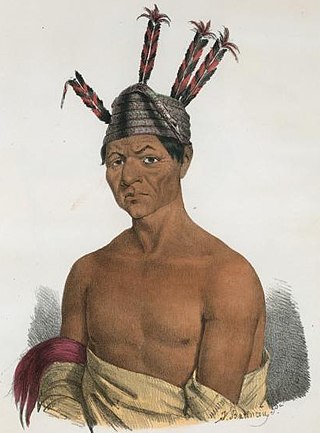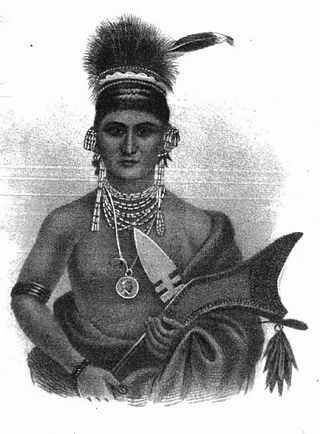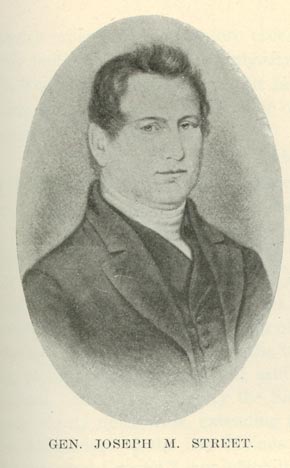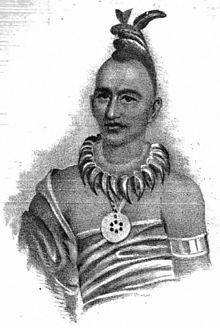
The Sauk or Sac are a group of Native Americans of the Eastern Woodlands culture group, who lived primarily in the region of what is now Green Bay, Wisconsin, when first encountered by the French in 1667. Their autonym is oθaakiiwaki, and their exonym is Ozaagii(-wag) in Ojibwe. The latter name was transliterated into French and English by colonists of those cultures. Today they have three federally recognized tribes, together with the Meskwaki (Fox), located in Iowa, Oklahoma and Kansas.

The Black Hawk War was a conflict between the United States and Native Americans led by Black Hawk, a Sauk leader. The war erupted after Black Hawk and a group of Sauks, Meskwakis (Fox), and Kickapoos, known as the "British Band", crossed the Mississippi River, to the U.S. state of Illinois, from Iowa Indian Territory in April 1832. Black Hawk's motives were ambiguous, but he was apparently hoping to reclaim land that was taken over by the United States in the disputed 1804 Treaty of St. Louis.

The Sac and Fox Nation is the largest of three federally recognized tribes of Sauk and Meskwaki (Fox) Indian peoples. Originally from the Lake Huron and Lake Michigan area, they were forcibly relocated to Oklahoma in the 1870s and are predominantly Sauk. The Sac and Fox Oklahoma Tribal Statistical Area (OTSA) is the land base in Oklahoma governed by the tribe.

Keokuk was a leader of the Sauk tribe in central North America, and for decades was one of the most recognized Native American leaders and noted for his accommodation with the U.S. government. Keokuk moved his tribe several times and always acted as an ardent friend of the Americans. His policies were contrary to fellow Sauk leader Black Hawk, who led part of their band to defeat in the Black Hawk War, was later returned by U.S. forces to Keokuk's custody, and who died a decade before Keokuk.

Black Hawk, born Ma-ka-tai-me-she-kia-kiak, was a Sauk leader and warrior who lived in what is now the Midwestern United States. Although he had inherited an important historic sacred bundle from his father, he was not a hereditary civil chief. Black Hawk earned his status as a war chief or captain by his actions: leading raiding and war parties as a young man and then a band of Sauk warriors during the Black Hawk War of 1832.

The Meskwaki, also known by the European exonyms Fox Indians or the Fox, are a Native American people. They have been closely linked to the Sauk people of the same language family. In the Meskwaki language, the Meskwaki call themselves Meshkwahkihaki, which means "the Red-Earths", related to their creation story.

Waukon Decorah, also known as Wakąhaga (Wau-kon-haw-kaw) or "Snake-Skin", was a prominent Ho-Chunk (Winnebago) warrior and orator during the Winnebago War of 1827 and the Black Hawk War of 1832. Although not a hereditary chief, he emerged as a diplomatic leader in Ho-Chunk relations with the United States.

Appanoose was a 19th-century Meskwaki chief who lived in Iowa; he was the son of Taimah and probably a grandson of Quashquame. Prior to European-American settlement in the 19th century, the tribe occupied territory in what became Michigan, Wisconsin, Illinois and Iowa.

General Joseph Montfort Street was a 19th-century American pioneer, trader and US Army officer. During the 1820s and 1830s, he was also a U.S. Indian Agent to the Winnebago and later to the Sauk and Fox tribes after the Black Hawk War. His eldest son was Joseph H. D. Street, the first appointed registrar of the Council Bluffs Land Office in western Iowa.

Wabasha II, also known as Wapahasha, Wapasha, or "The Leaf," succeeded his father as head chief of the Mdewakanton Dakota tribe in the early 1800s. He led the Dakota forces fighting with the British in the War of 1812, but sided with the United States in the Black Hawk War of 1832. Chief Wabasha II signed the Treaties of Prairie du Chien in 1825 and 1830.

Wapello was a Native American chief of the Meskwaki tribe.

Quashquame was a Sauk chief; he was the principal signer of the 1804 treaty that ceded Sauk land to the United States government. He maintained two large villages of Sauk and Meskwaki in the early 19th century near the modern towns of Nauvoo, Illinois and Montrose, Iowa, and a village or camp in Cooper County, Missouri.

Meskwakiinaki, also called the Meskwaki Settlement, is an unincorporated community in Tama County, Iowa, United States, west of Tama. It encompasses the lands of the Meskwaki Nation, one of three Sac and Fox tribes in the United States. The others are located in Oklahoma and Kansas. The settlement is located in the historic territory of the Meskwaki (Fox), an Algonquian people. Meskwaki people established the settlement in 1857 by privately repurchasing a small part of the land they had lost in the Sac and Fox treaty of 1842.

Several Native American tribes hold or have held territory within the lands that are now the state of Iowa.

The Treaty of Prairie du Chien may refer to any of several treaties made and signed in Prairie du Chien, Wisconsin between the United States, representatives from the Sioux, Sac and Fox, Menominee, Iowa, Ho-Chunk and the Anishinaabeg Native American peoples.

The Treaty of Prairie du Chien may refer to any of several treaties made and signed in Prairie du Chien, Wisconsin between the United States, representatives from the Sioux, Sac and Fox, Menominee, Ioway, Winnebago and the Anishinaabeg Native American peoples.

The Treaty of Prairie du Chien may refer to any of several treaties made and signed in Prairie du Chien, Wisconsin between the United States, representatives from the Sioux, Sac and Fox, Menominee, Ioway, Winnebago and the Anishinaabeg Native American peoples.

The Treaty of St. Louis of 1804 was a treaty concluded by William Henry Harrison on behalf of the United States of America and five Sauk and Meskwaki chiefs led by Quashquame.
The New Purchase of 1842 is a treaty between the United States and the Sauk and Meskwaki tribes, referred to as the Sac and Fox in the treaty. The Native American tribes ceded land in Iowa west of the Mississippi River and north of the Missouri border.

















